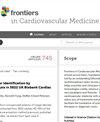经皮冠状动脉介入治疗后,甘油三酯-葡萄糖指数与 2 型糖尿病 STEMI 患者的无回流现象有关
IF 2.8
3区 医学
Q2 CARDIAC & CARDIOVASCULAR SYSTEMS
引用次数: 0
摘要
背景2型糖尿病(T2DM)合并急性ST段抬高型心肌梗死(STEMI)患者的甘油三酯-葡萄糖(TyG)指数与经皮冠状动脉介入治疗(PCI)后无回流现象之间的关系仍不清楚。本研究旨在探讨基线TyG指数与T2DM STEMI患者PCI术后无复流现象的关系。方法本研究纳入了宁夏医科大学总医院(2014-2019年)的695例T2DM和STEMI患者。根据TyG指数水平将患者分为三组。记录无回流现象的发生率。建立多变量回归模型分析基线TyG指数与无回流现象之间的关系。通过平滑曲线拟合和平行分组分析,探讨了基线TyG指数与无复流现象之间的线性关系。结果 多变量Logistic回归模型显示,TyG指数是无复流现象的独立危险因素[OR = 3.23,95%CI:2.15-4.86,P &;lt;0.001],无复流现象的发生率随TyG指数梯度间隔的增加而逐渐增加(P &;lt;0.001)。平滑曲线拟合显示,TyG指数与无复流风险呈线性关系。亚组分析表明,它们参与了这种正相关。结论TyG指数与无回流现象独立相关,表明TyG指数这一简单指标可用于T2DM STEMI患者PCI术后无回流现象的风险评估。本文章由计算机程序翻译,如有差异,请以英文原文为准。
The triglyceride–glucose index is associated with no-reflow phenomenon in STEMI patients with type 2 diabetes after percutaneous coronary intervention
BackgroundThe relationship between the triglyceride–glucose (TyG) index and no-reflow phenomenon after percutaneous coronary intervention (PCI) in patients with type 2 diabetes mellitus (T2DM) and acute ST-segment elevation myocardial infarction (STEMI) remains unclear. This study aimed to investigate the relationship between baseline TyG index and no-reflow phenomenon in STEMI patients with T2DM after PCI.MethodsThis study enrolled 695 patients with T2DM and STEMI from the General Hospital of Ningxia Medical University (2014–2019). Patients were divided into tertiles according to the TyG index levels. The incidence of no-reflow phenomenon was recorded. A multivariate regression model was developed to analyze the association between the baseline TyG index and no-reflow phenomenon. The linear association between the baseline TyG index and no-reflow phenomenon was explored using smooth curve fitting with parallel subgroup analyses. Receiver operating characteristic (ROC) curves were generated to determine the predictive power of the TyG index.ResultsA multivariate logistic regression model revealed that the TyG index was an independent risk factor of no-reflow phenomenon [OR = 3.23, 95%CI: 2.15–4.86, P < 0.001], and the occurrence of no-reflow phenomenon increased gradually with the increase of TyG index tertile interval (P < 0.001). Smooth curve fitting showed that the TyG index was linearly related to the risk of no-reflow. Subgroup analysis showed that they participated in this positive correlation. The area under the ROC curve (AUC) of the TyG index for evaluating the occurrence of no-reflow was 0.710 (95% CI: 0.640–0.780; P < 0.01).ConclusionsThe TyG index is independently associated with no-reflow phenomenon, suggesting that the simple index of the TyG index can be used for risk assessment of no-reflow phenomenon after PCI in STEMI patients with T2DM.
求助全文
通过发布文献求助,成功后即可免费获取论文全文。
去求助
来源期刊

Frontiers in Cardiovascular Medicine
Medicine-Cardiology and Cardiovascular Medicine
CiteScore
3.80
自引率
11.10%
发文量
3529
审稿时长
14 weeks
期刊介绍:
Frontiers? Which frontiers? Where exactly are the frontiers of cardiovascular medicine? And who should be defining these frontiers?
At Frontiers in Cardiovascular Medicine we believe it is worth being curious to foresee and explore beyond the current frontiers. In other words, we would like, through the articles published by our community journal Frontiers in Cardiovascular Medicine, to anticipate the future of cardiovascular medicine, and thus better prevent cardiovascular disorders and improve therapeutic options and outcomes of our patients.
 求助内容:
求助内容: 应助结果提醒方式:
应助结果提醒方式:


